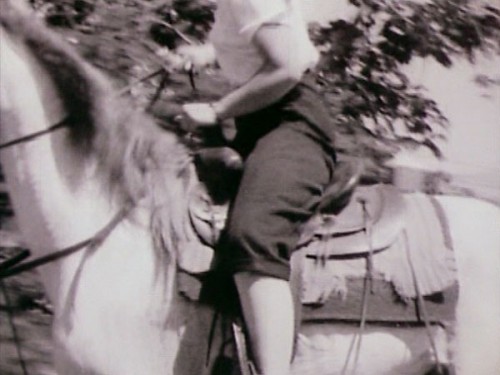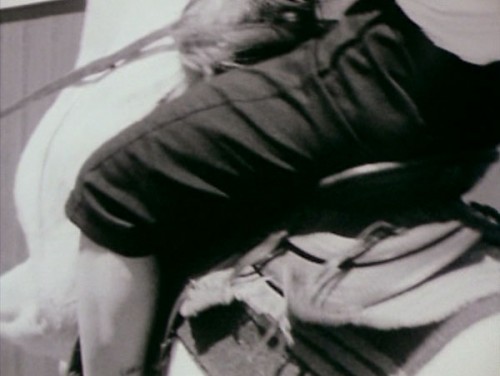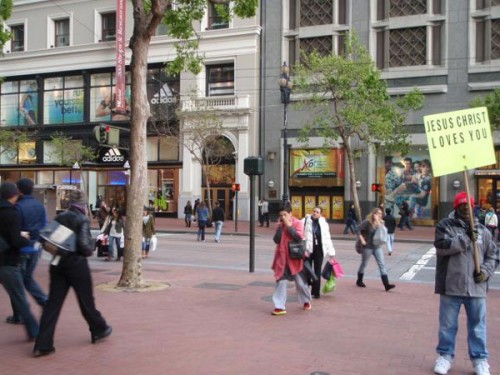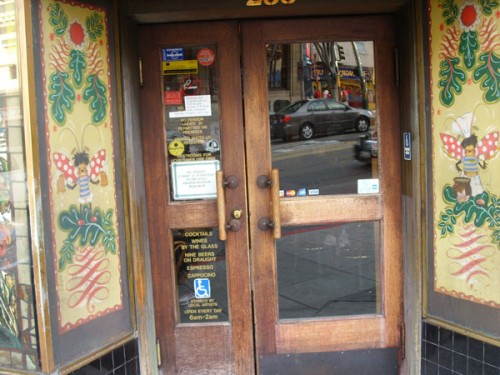In Search of Christopher Maclaine 17: The THE END Tour - A Work in Progress 15: CLIMAX B
This is the seventeenth in a multipart series unofficially conjoined to the publication of Radical Light: Alternative Film & Video in the San Francisco Bay Area, 1945–2000, and the accompanying film series currently being presented by the Pacific Film Archive and San Francisco Cinematheque (in partnership with SFMOMA).
With my friend Brian Darr, proprietor of the great Bay Area cinephilia blog Hell on Frisco Bay, I’ve been scouting out the San Francisco locations used in Christopher Maclaine’s Masterpiece, THE END. What began as an attempt to identify and document what physically remains of the often mysterious places at which THE END was shot has evolved into a larger project to also analyze the film, and to identify all its many actors and extras, all of whom appear uncredited. To read the full version of these preliminary remarks, including info on how YOU can participate in this project, click here. For further information on Maclaine, check out the intro, which serves as this series’s hub. For the previous post of this Tour, click here.
NEW FEATURE: a YouTube of the CLIMAX B episode is viewable here.
NOTE: portions of Maclaine’s Voice-Over narration are transcribed in italicized sections. The images, for the most part, are stills documenting many (but by no means all) of THE END‘s shots. Those unfamiliar with this film will probably want to watch the video clip found above first, before making their way through the (hopefully enjoyable) notes and explication.
As this is the last post of our Tour, I’d be remiss in not taking the opportunity to exhort locals who have been following this series to attend the exciting S.F. Cinematheque show Radical Light: In Search of Christopher Maclaine: Man, Artist, Legend, to be presented by yours truly and Brian at SFMOMA on March 31st! Now, on to our regularly scheduled post: Chris’s/”A Character’s” ongoing Vision of the last 2¼ posts continues: the dumbshow symbolism of ecstatic sexuality which had ended the PIPEGIRL and MATCHMAN episode (CLIMAX A) is now projected onto the entire world, as represented by the people and environs of the Bay Area …
1) Including at least some of its fauna: as the fourth movement of Johann Sebastian‘s Brandenburg Concerto No. 1, BVW 1046 continues, a young (unidentified) woman rides her horse at a gallop down what could be an equestrian path in Golden Gate Park. The eroticized relationship women sometimes have to their horses is well known.
2) What could be called the foreplay of the PIPEGIRL/MATCHMAN episode gives way immediately in CLIMAX B to overt sexual symbolism: the horn of this equestrienne’s Western saddle is prominently framed by Belson and Maclaine at an angle to suggest it’s the rider’s clitoris suffering, or more probably enjoying, a state of gigantism. As horse and rider continue their journey, the filmmakers’ camera pans to follow, paying avid attention to the woman’s rear end. Fortunately for the prudish, Maclaine then cuts to less sexualized imagery:
3) An automated sprinkler engaged in its duties in the park: what could be more innocent?
4) As she rides her beast, the young woman is jolted up and down on her saddle.
5) The jolting continues from a more interesting angle.
6) Now, why are we back to the sprinkler, Chris? Hmm … Your camera is panning right to follow the stream…
7) … to take in the sight of the pulsing stream coursing against the trunk of a tree. Woah, Chris … You’ve invented the “arboreal money shot”!
8 ) Horse and rider rear up.
9) Maclaine cuts to a classic example of one of the shots of seemingly random imagery which permeate THE END: a crowd of people await the cable car at the location of its turnaround on the intersections of Market, Powell, and Eddy, as seen from an angle roughly similar to those of CHARLES B and C. (This area was also visited later in JOHN A.) For Charles, this was the site trod by the last of the “Jocasta stand-ins,” who seemed to agitate his Oedipal wound; it was also the location of his fantasized suicide. For John, the cable car being spun about on its turnaround here was an image of “diurnal futility.” Like for his character analogues, no doubt this place was psychically charged for Maclaine — perhaps due to it being a swirling vortex of human activity representative of the society from which he was alienated.
But to deal with the image at hand: Maclaine shall cut from this shot to another featuring at least one of the same figures. Will it be the older lady, the fat man standing near her, or the Latina with her son on the far right?
10) A recent photo from roughly the same position/angle seen in the shot depicted in picture 9, immediately above. The more things change, etc.: the vortex continues its swirl, and still attracts millenarian attention — though evidencing none of Maclaine’s imagination or talent, the “JESUS CHRIST LOVES YOU” placard indicates a related estrangement from society and reforming impulse: both film and sign attempt to hold up mirrors to society’s madness, and suggest spiritual connection as antidote.
11) To answer the question posed at the end of #9, above — the fat man is the winner! Although the Latina’s son stands to the fat man’s right (and the Latina herself seems to be peeking over the fat man’s shoulder), the fat man is unquestionably the center of attention of this shot of a cable car speeding up Powell with a fresh load of passengers.
12) Maclaine cuts back to the shot previously seen in 8, above. Horse and rider are at first still reared back, and then the horse eases his front hooves back to the ground, bringing its rider down with it. The center of attention here is the rider’s nicely plump posterior. Look, folks, this may be going a bit far, but after many dozens of viewings, I’ve concluded that what goes on here is among Maclaine’s most outrageous visual sexual metaphors of THE END: sometimes a fat man seen at some distance in the frame isn’t just a fat man! Reversing the misogyny evinced in 11–13 in CHRIS A, Maclaine, through his brilliant Eisensteinian intellectual montage, employs the fat man taken off within the cable car as a metaphor for our equestrienne taking a pleasingly fat male member into her sex …
13) … which seems to be pleasing for the “fat male member,” as well!
14) Ah, bliss! For the first time, we see our equestrienne’s face as she and her horse charge down the trail.
15) Charge on!
16) Ah, tiny sprinkler, your efforts fructify the parched earth and vegetation!
17) The rhetorical alternation of sprinkler and jiggling equestrienne seems to have effected a kind of conjuration upon the land: fellowship and goodwill have broken out! On Adler Alley (now Jack Kerouac Alley), with the legendary bar Vesuvio as backdrop, two unidentified hipsters give each other the sincere gladhand.
18) The walking wounded are with us still, but now they limp against the traffic.
Brian and I have identified this shot as looking up Grant Ave. north toward Chinatown, from the SW corner of Post. The metal plaques on the building at the far left of the frame indicate this to be the location of Shreve & Co., a San Francisco jewelry store founded in 1852, and residing in this building since shortly before the 1906 earthquake.
19) A recent photo. Shreve & Co. is still in business, with its metal plaques intact.
20) Horse and rider continue their galloping invocation of Eros.
21) As the camera pans left toward the sprinkler, the latter’s jet shoots across the frame like a ray of fecundating energy.
22) Dig that crazy Panama, baby! The hipsters from #17 chat enthusiastically. We have no idea if this shot was taken before or after the famous Beat/paperback bookstore City Lights was founded in 1953 (the same year as THE END‘s premiere), but the filmmakers were standing right alongside its 261 Columbus Ave. location.
23) More deserved attention is paid to our equestrienne’s ripe rump …
24) … and our little fellow jets out his familiar response.
25) Further fellowship ensues! As he shaves a customer, this friendly seeming barber reacts in fine spirit to the scrutiny of Belson and Maclaine’s camera as it peers through his window.
26) His friend apparently departed, the un-Panama-d hipster enters Vesuvio.
27) A recent photo. This bar beloved by the Beats is still going strong almost sixty years after THE END‘s production.
28) You can see why our un-Panama-d friend would want to enter this establishment, especially amidst the hot-n’-heavy yet joyous atmosphere Maclaine’s been laying down: Vesuvio would appear to be a temple of love designed by Cupid’s helpers. This location was highly attractive to Beat filmmakers: Dion Vigne would film his wife Loreon in front of these doors several years later for his brilliant and ecstatic NORTH BEACH (1958).
Vesuvio’s entrance was painted by San Francisco artist Wolo, who, to go on perhaps an extreme tangent, worked on Charles Walters‘s MGM production LILI, released in 1953, the same year THE END had its premiere. The charming LILI, starring my definition of charming, Leslie Caron, was reportedly the only movie to charm that famous movie hater H. L. Mencken.
29) A recent photo. The Vesuvio door circa 1953 has long since been replaced. Fortunately, Wolo’s original door panels were relocated inside to either side of the entrance.
This shot is repeated once, but several other interesting images intervene, which for brevity’s sake have been omitted, such as: a woman walking her dog, the legs of two either epicene or androgynous people making their way down the sidewalk, and more semi-flirtatious play with the barber.
30) In interplay with more images of our lovely on horseback, this little guy keeps shooting it out! Perhaps it will never end …
31) “But no,” Maclaine might intone if he were narrating his film’s finale, echoing his announcement of Walter’s impending demise. All this joyous hanky-panky must end. The bombs are going off.
Let me just mention in passing how much I’m taken with this type of long-gone San Francisco traffic signal; its version of “GO” can be seen toward the top right of image #18.
32) Beginning with this characteristic emblem of the Cold War, the “AIR RAID SHELTER” sign, Maclaine treats us to one of the most dizzyingly lyrical and elegiac sequences of THE END: a black-&-white montage largely composed of static shots of people’s faces as the sudden flashes of nuclear explosions illuminate their features …
33) … such as this visibly-shocked fellow identified by Wilder Bentley II as Marty Horowitz …
34) … or this one Wilder remembers well, but can only identify by his first name: Danny, “who usually worked as a hospital orderly.”
35) Bach’s Brandenburg Concerto No. 1 is suddenly halted to make way for a throaty air-raid siren as we view this shot looking up at the underside of the Golden Gate bridge as the camera passes below. The bay’s fog no doubt stands in for a bomb-created smoke cloud.
36) As the Bach returns, a man Wilder has identified as John Manfredi glances over to the camera and smiles …
37) … as does this Unidentified Woman without smiling …
38) … while another Unidentified Woman neither smiles nor looks at the camera. Wilder remembers her, but not her name.
39) But he does recall this fellow being named Ben Rosenbluth, and believes the drugstore he stands in front of was in Berkeley. In fact, all the people Wilder can identify from this sequence were members of “the Berkeley scene” — and Wilder ought to know, having grown up there. They were all likely associates in some fashion of Maclaine’s, as he’d spent a good number of years in Berkeley attending the University of California, and also as a participant in the Berkeley Renaissance, at least as publisher and editor of CONTOUR.
The effect of having these rather intimate portraits of seven until now unknown individuals is to bring home the Ultimate Tragedy a nuclear war would represent: if we’d grown the slightest bit complacent in response to the stories of those Maclaine at one point described as “violent and suicidal,” we are now reawakened with a shock by a series of faces we’ll never know other than for these passing seconds. A few more seconds will pass, or perhaps minutes, and they’ll be dying, or at least on their way to some hideous doom.
All this was no doubt especially shocking in 1953, but the passing decades have added the compounding element of time: despite the names and some information (which will be revealed at a later time) provided about these people by Wilder, at the remove of almost sixty years they are inevitably for the most part lost in the winds of time …
… as we all shall be at some point. We shall all die, and memory of our passing existences will eventually be effaced. In the maturing process, every human must confront inevitable death; only since 1945, eight years before THE END‘s production, has each and every thinking person also had to confront the possible death of everyone, in fact of all living beings on the planet in possibly one go … And to consider that he or she is part of the species that might bring on this Final Disaster … And if one is American, there is a special culpability in being part of the culture that brought things to this pass, no matter how necessary it seemed by those in power at the time … And there is so little one can do about it, like the basic fact of mortality itself … Except perhaps to live the best one can, until …
40) As Bach’s Brandenburg Concerto No. 1 (which to my taste is an even more apt choice for “the most beautiful music in the world” than Beethoven’s obviously magnificent Symphony No. 9) continues, the film’s opening title credit becomes its end credit. Unlike the opening title, however, a strange dark object (perhaps evoking the top of a dark mushroom cloud seen from an aerial view) has been added behind THE END.
41) We see the flash of a nuclear explosion (perhaps an H-bomb?). This is stock footage, which means it’s absolutely real.
42) We see a flash of the THE END credit again (including what appears to be a strange reflection), then cut to the erection of a nuclear cloud’s mushroom.
43) We get yet another glimpse of the THE END credit, which moves toward the camera: it is fixed on glass somehow. As it draws near, we also get a clearer, if fleeting, view of the “strange reflection” discussed immediately above (which is impossible to make out in stills): it’s a man holding a camera. This would have to be Jordan Belson, no? We then cut to this image of the nuclear cloud previously seen at the beginning of the first Tour episode.
44) The THE END draws rapidly closer, bringing into relief the “strange dark object” added behind THE END: it looks to be a metal plate of some kind.
45) (Shot contd. from 44, immediately above.) Then THE END suddenly falls, crashing onto the surface below and shattering …
46) (Shot contd. from 45, immediately above) … into shards. We might have the impression the cameraman disappears as the glass and words fragment into smithereens. Does Jordan Belson stand in for all of THE END‘s filmmakers, most especially Maclaine? Is THE END‘s auteur in this manner acknowledging his own potentially apocalyptic demise?
The image cuts to black as Bach’s music winds down … THE END has ended. As usual in Maclaine’s film, joy has given way somewhat to dark ruminations, but ecstasy has not been routed, but rather entwined with despair. Man’s sexuality is a source of Ultimate connection, but his and her technology, as handy as it is, could lead to ultimate Downfall. THE END presents us with a Cosmic Vision by which to contemplate our future, and both protests against, and reconciles us to our fates.
Click as indicated for the previous post of this Tour. Click as indicated for the intro to this series.
Click as indicated for information on the San Francisco Cinematheque show Radical Light: In Search of Christopher Maclaine: Man, Artist, Legend, to be presented at SFMOMA on March 31st.
Click here for an interview with Stan Brakhage concerning Maclaine, circa 1986.
If you have any information or (nonpublic) feedback to contribute to the Tour, please click here.
And thus The THE END Tour concludes, but the Search continues: our next post, as if we haven’t exhausted the subject, shall be a wrap-up on THE END. Various sporadic Maclaine-related posts, including individual articles on his other films, as well as interviews with extant friends and collaborators will follow in the months to come.














































Comments (2)
Thanks for this wonderful contribution to the history, Catherine! I shall be closely perusing your highly interesting and detailed family chronicle in upcoming days. Your uncle also designed the cover of the first two issues of Maclaine’s CONTOUR, BTW, and had three of his paintings reproduced in b&w in issue #2 (1947). Please click on the “nonpublic feedback” button above if you’d care to dialogue.
Yours,
Brecht
Wow! My uncle John Manfredi! I recognized him right off — i was born in 1947 and that is him as he was throughout my youth in Berkely. Yes, that is him. He was a zoot-suited hipster during the 1940s and, yes, hung out at the Vesuvio in North Beach — but after the war, he lived in Berkeley, along with his brother Joseph (“Fred”) Manfredi and my mother Liselotte (“Lilo”) Erlanger Manfedi. They were all beatnik / bohemians. John and Fred painted and John also wrote illustrated poems. Sadly uncle John became a heroin addict during the mid to late 1950s and was jailed a few times and even locked up in Napa at the mental hospital at once. He went to Mexico and took peyote, too. I remember him well in 1960 on Telegraph Avenue, bumming and writing poetry for me. He died on August 16th, 1962 in Norwalk, Los Angeles County, California. Read more about John Manfredi and his family here, on the MANFREDI – MARINO – PERCOCO – GIANGRASSO Sicilian Genealogy page.